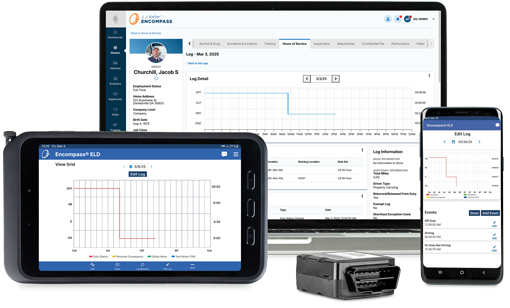Sr. Transportation Management Editor — J. J. Keller & Associates, Inc.
ELD DataQs: Guidance and Tips
You have an interest in ensuring your public CSA data is accurate. DataQs is the way to challenge erroneous violations.
Published On: 04/30/2019


Written by:
Mark Schedler
You and the FMCSA have a vested interest in accurate federal and state data being released to the public via the CSA website. In the event of an erroneous violation on a roadside inspection report, the DataQs system is an electronic means of filing a request to the FMCSA or state agency to review the violation(s) in question.
What Happens When an ELD Violation is Received When Using an AOBRD?
AOBRDs have been allowed since 1988 without regulatory changes being made to reflect subsequent technology updates. As such, while many AOBRD solutions well exceed the requirements, what the devices must do is rather limited. ELDs on the other hand, are expected to meet multiple technology requirements.
AOBRDs installed and used by a driver before December 18, 2017 may continue to be used until December 16, 2019. Carriers using compliant AOBRD devices are nonetheless sometimes cited or receive roadside inspection violations because the device does not perform as an ELD. This can occur because the driver, officer, or both do not understand the differences between AOBRDs and ELDs. The first line of defense is for the driver to be aware of the type of device being used, the expectations of the device at a roadside inspection, and how to operate the device for an inspection. When this line of defense fails, the citation can be challenged in a civil court to adjudicate the ticket. The violation’s accuracy can be corrected through the FMCSA's DataQ process.
Reasons to Consider Filing a DataQ
Officer expected the ELD to:
Print paper copies when compliant information is displayed
Transfer data without a cell signal
Provide hard copies of manual and other required documentation when available electronically
Officer expected the AOBRD to:
Transfer data
Show unassigned driving events
Display detailed grid
Be on the registry
Applicable Regulatory Citations & FMCSA Interpretations
The following regulatory citations may be used to adjudicate a citation or complete a DataQ for a roadside inspection violation:
49 CFR 395.8(a)(1)(ii), A motor carrier that installs and requires a driver to use an automatic on-board recording device in accordance with §395.15 before December 18, 2017, may continue to use the compliant automatic on-board recording device no later than December 16, 2019.
49 CFR 395.15(i)(5), Automatic on-board recording devices with electronic displays shall have the capability of displaying the following:
(i) Driver’s total hours of driving today
(ii) Total hours on duty today
(iii) Total miles driving today
(iv) Total hours on duty for the 7 consecutive day period, including today
(v) Total hours on duty for the prior 8 consecutive day period, including the present day
(vi) The sequential changes in duty status and times the changes occurred for each driver using the device
FMCSA interpretation of 49 CFR 395.15, question 5:
What information is required to be displayed on the AOBRD?
Guidance:
(1) Section 395.15(i)(5) requires that AOBRDs with electronic displays must be capable of displaying the following:
(i) Driver’s total hours of driving today;
(ii) The total hours on duty today;
(iii) Total miles driving today;
(iv) Total hours on duty for the 7 consecutive day period, including today;
(v) Total hours on duty for the prior 8 consecutive day period, including the present day; and (vi) The sequential changes in duty status and the times the changes occurred for each driver using the device.”
(2) While §395.15(c) requires additional information be recorded bythe AOBRD, only the specific information listed in §395.15(i)(5) must be displayed.
(3) The two provisions differ because of the data display limitations of a minimally compliant AOBRD.
FMCSA interpretation of 49 CFR 395.15, question 6:
Must an AOBRD be capable of providing a hardcopy printout?
Guidance:
No, the FMCSRs do not require AOBRDs to provide a hardcopy printout for an enforcement official. As long as the information made available for display on the AOBRD meets the requirements of §395.15(i)(5), the driver and motor carrier are not required to provide additional RODS documentation to an enforcement official at the roadside. However, an enforcement official mayrequest that additional information be provided by email, fax, or similar means within 48 hours for follow-up after the conclusion of the roadside inspection.
What is a “grandfathered” automatic onboard recording device (AOBRD)?
A “grandfathered” AOBRD is a device that a motor carrier installed and required its drivers to use before the electronic logging device (ELD) rule compliance date of December 18, 2017. The device must meet the requirements of 49 CFR 395.15. A motor carrier may continue to use grandfathered AOBRDs no later than December 16, 2019. After that, the motor carrier and its drivers must use ELDs. See Section 395.15 (a) of the ELD final rule.
You may also enjoy the following articles:
Sign up for our newsletter!
We'll help you stay on top of regulations, best practices, and fleet industry news. Sign up to receive a monthly email notification with links to our most recent blog articles, free resources, and event invites.
